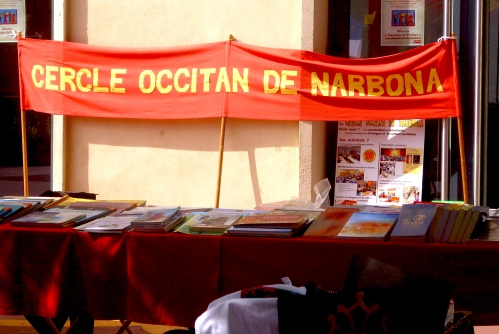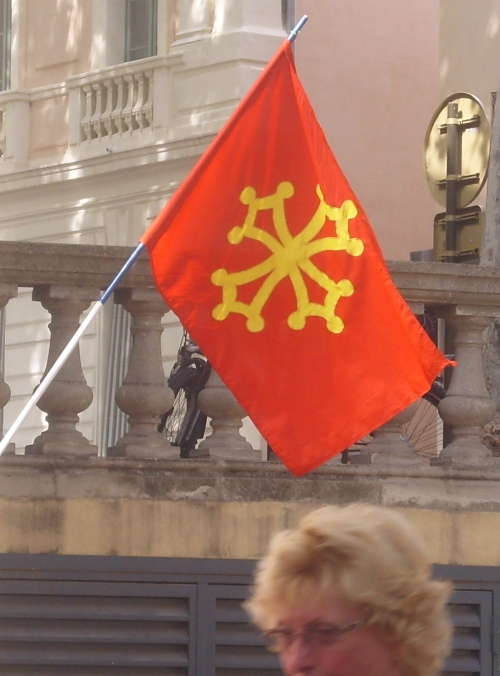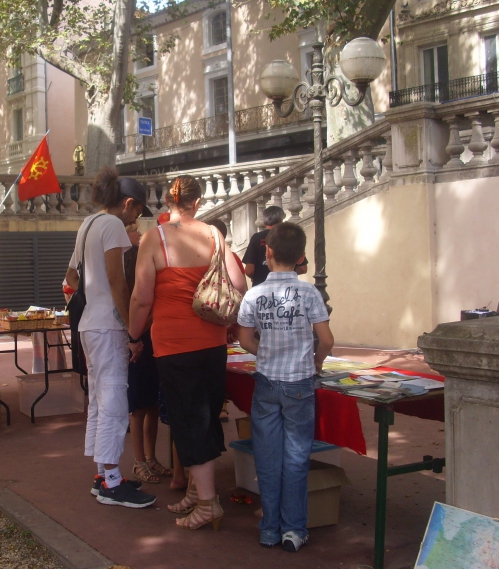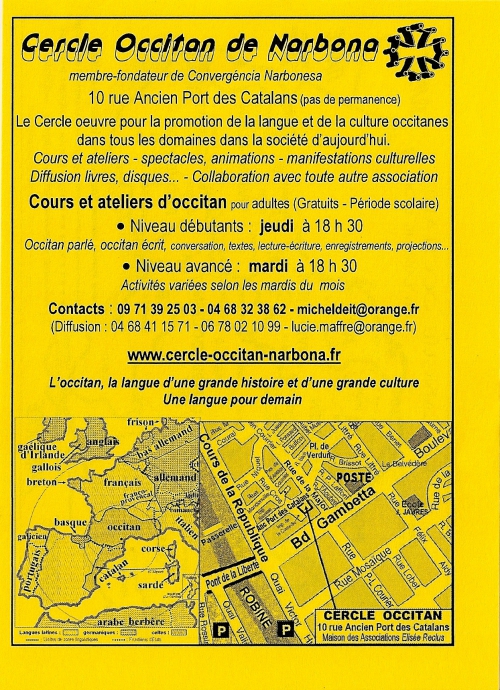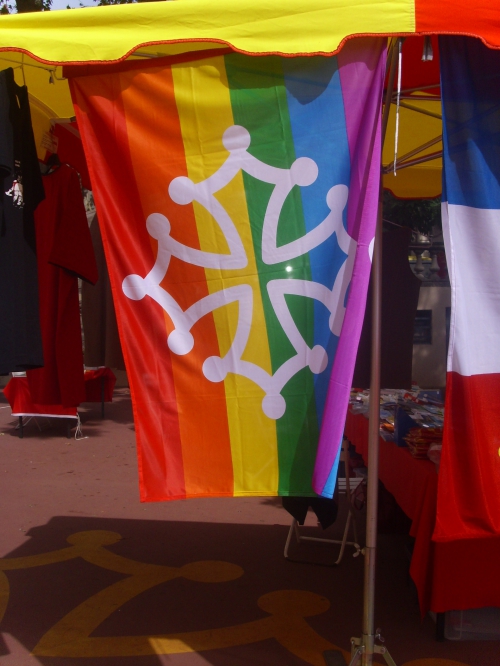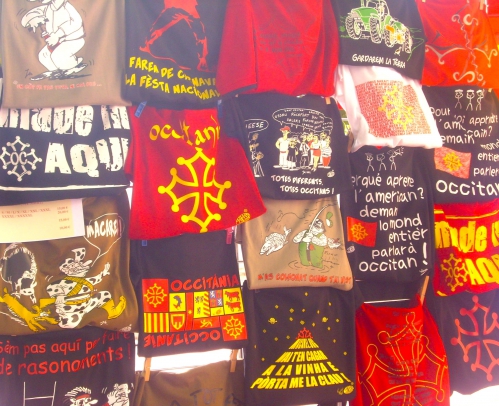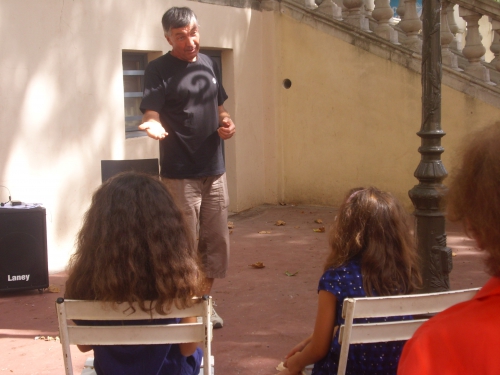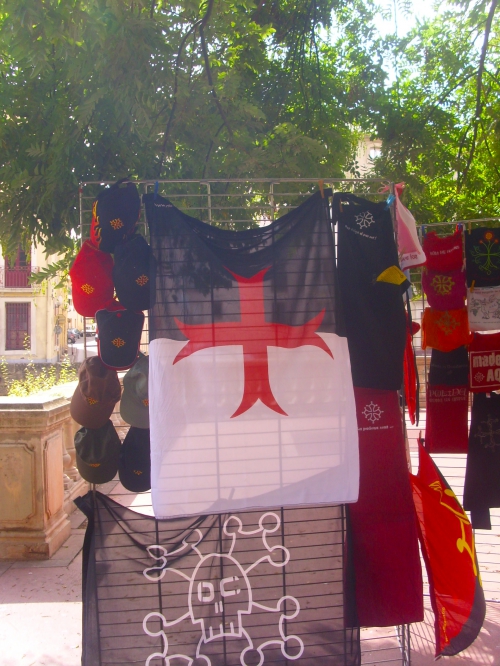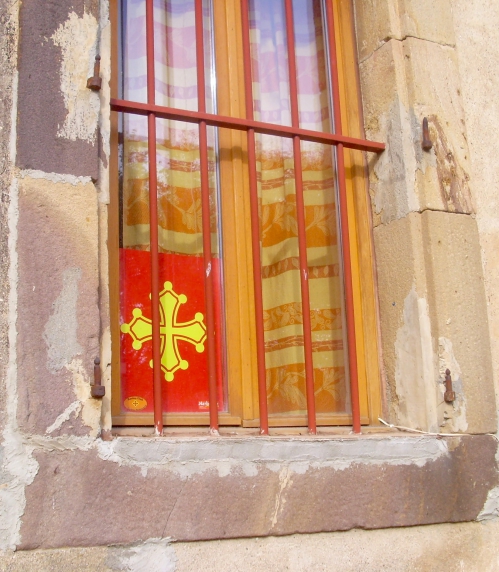ADVENTURES - Narbonne
The Occitan Circle of Narbonne
A party with Occitan friends
In September 2014 I went to Narbonne for the "Journée de Patrimoine" held every year and found a delightful presentation in the courtyard overlooking the canal beside the Office de Tourism.
A lady - the blonde by the flag - came up to me and spoke English as soon as she heard my accent! Apparently many English people in Narbonne are going to Occitan classes, held every Thursday at 6-30pm. We had a look at the "free" stall. I came away with arms laden!
I was surprised by how popular Occitan is becoming. They gave me an annuaire, or directory, of Occitan businesses and groups, all over southern France, from the Dordogne to Provence, and Occitan is also spoken in northern Italy. I looked at endless things for sale, all the stickers and flags and tee-shirts that you could desire. But they had already given me an Occitan Poster and the words in French of the "National Anthem" - Se Canta.
But of course, it was the books that interested me.
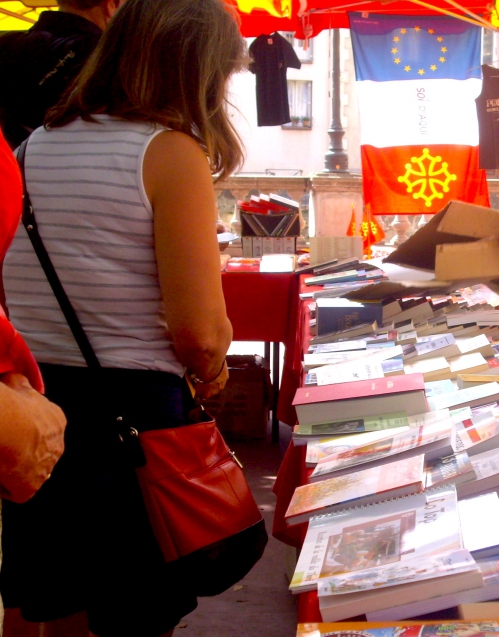
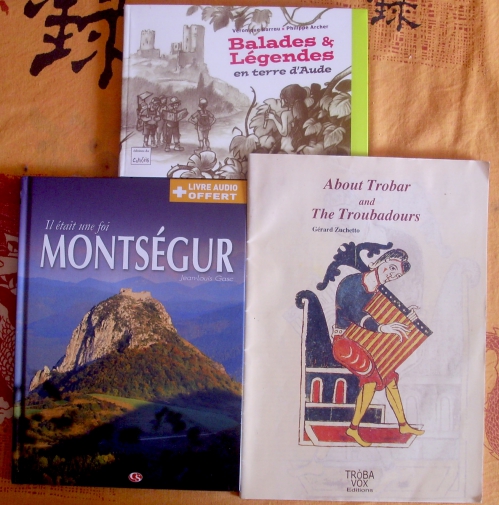
I bought three; a book of legends (all good stuff - ghosties and witches and things that go bump in the night), the wonderful Montségur book by Christian Salès and a book about the troubadours, in English! They will all help me greatly in my researches into all things Occitan.
Meanwhile, I was a little disappointed the entertainment did not include music, which I love, but they had a "Conteur" or storyteller. This is a great tradition, from the days of the Cathars or before. Especially on cold winter nights, evenings were held where the great conteurs vied with each other to tell the best tale. This was done in a particular style, with facial expressions, gestures, imitations of local people and risqué jokes. Now you can learn about it at classes, and by learning simple tales, the children learn Occitan.
Meanwhile, I know not the connection between the Templar flag and the skull and crossbones with Occitania! When I got home I put my poster in the window.
Alèu! A l'an vèn, que se sèm pas mai qui siem pas mens. See you soon, until next year - if there are not more of us, let there not be less.
A party with Occitan friends
An insight into the Occitan way of life.
In September 2013 I was invited to a party to celebrate a bust of the Roman Emperor, Antonin the Pious, who ruled from 138 to 161. My friend Michel was placing it in his very large garden and was holding an inauguration ceremony in front of his house. He and I are members of various historical societies in Narbonne, as were many of the other guests.
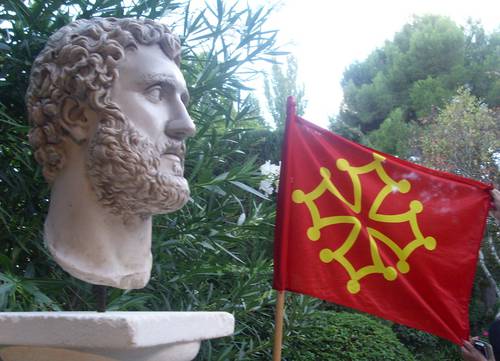
Occitan people appreciate the Romans and the Roman culture, for the Occitan language is descended from Latin. Narbonne was founded in 118BC and was the Roman capital of Gaul for more than three hundred years.
Antonin is particularly popular in this part of the world because he came from Nîmes, in Occitania, and was also a benefactor of Narbo Martius - the Roman name for Narbonnne.
Admiring this man, last year Michel made a mosaic of him, but then wanted more, so he commissioned the bust. It was done by a sculptor lady called Brigitte, who had to go to Toulouse to do it, for the original is in the Saint-Raymond museum there and cannot be loaned out. The bust was found at the Villa of Chirigan, Martres-Tolosane, along with many other marble statues, in the middle of the 19th century.
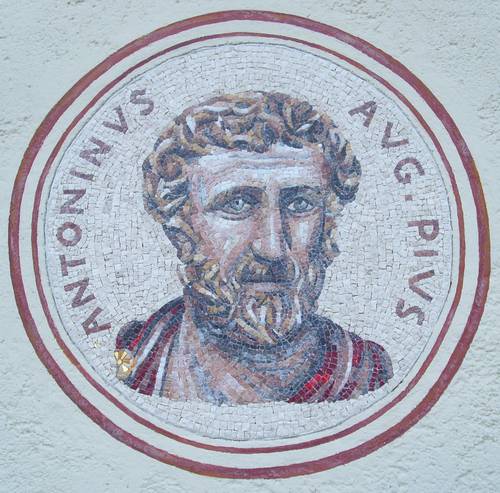
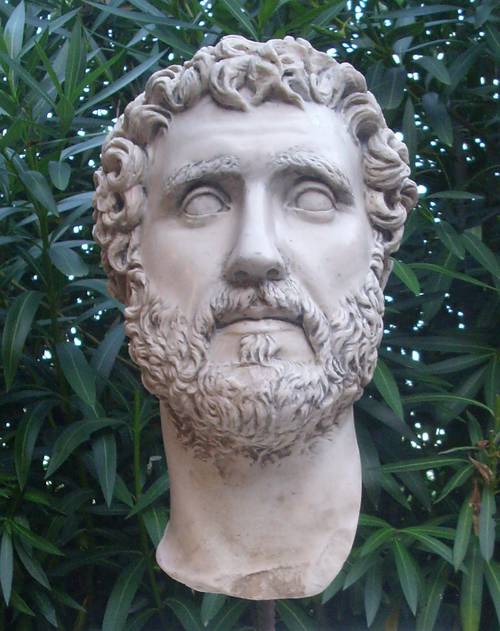
The image on the left is actually a mosaic, called "L'Empereur Antonin le Pieux" on the wall of the house, made by the mosaic artist, France Dodin, with "marbles et pâtes de verre sur mortier" for the Domaine St. Felix, at Narbonne. France is well-known in the Narbonne region, and holds classes with the MJC of Narbonne. (MJC mean "Maison Jeune et Culturelle.") She runs the "Atelier Mosaique" on Monday afternoons and Saturday mornings. You can telephone France Dodin on 06 68 45 72 61
The speeches were led by Madame Cathala, the councillor for culture at Narbonne, who thanked Brigitte (in red) and they explained how the work of copying the bust was done.
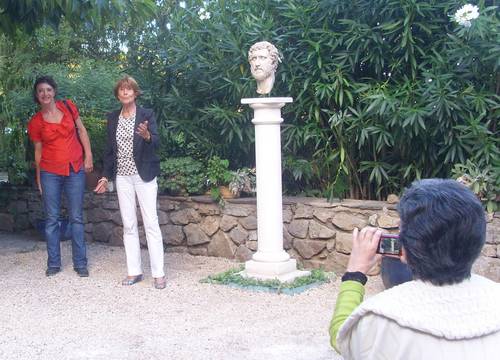
Also at the party were the well-known couple, Yves Rouquette and his wife Maria Roanet. From Bézier, they are leading lights of the Occitan scene. They began their joint promotion of the Occitan culture in the 1950’s. They have both written many books and Marie is a well-known singer in Occitan in the region. When she began her songs were recorded on 78 records! You can hear her incredible voice by clicking here.
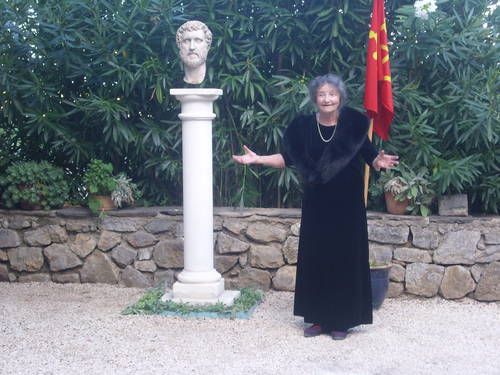
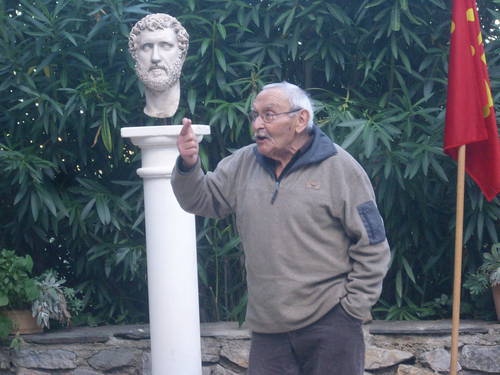
She gave us a talk about the Felibrige group (that my previous life belonged to) under Frédéric Mistral, while her husband, well known for his work protecting the rights of wine-growers and their workers, made many jokes about his socialism.
Then followed all sorts of delights; a presentation of organic grape juice from the wine-makers Pech Rouge at Gruissan, and a tasting of wines made to Roman recipes (totally without the use of sulphites) even a wine named after "Antonin Le Pieux." The lady told us an unusual tale; the Romans used to train their vines up other fruit trees, so the pickers could pick grapes and apples at the same time. But if by mischance a worker fell from the tree, their Roman overlords financially supported him; shades of both Antonin and socialist principles here!
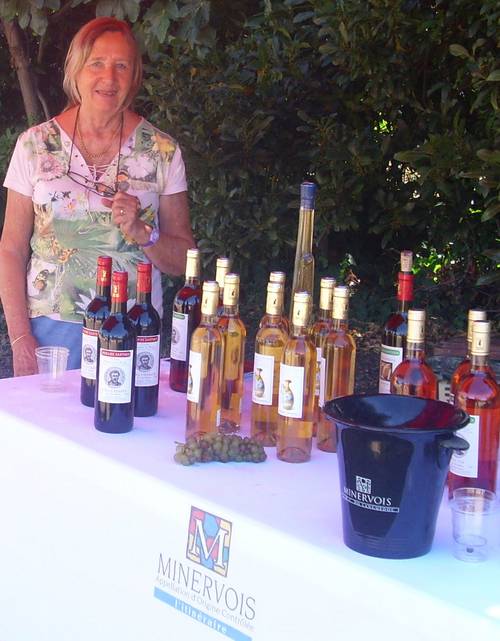
Then a Repas Champêtre, that is, an outdoor picnic where everyone brings something, then a concert of music, such as by Charles Trenet from Narbonne and George Brassens from Sète, plus Occitan songs, poems and story-telling. Vive Lenga d'Oc!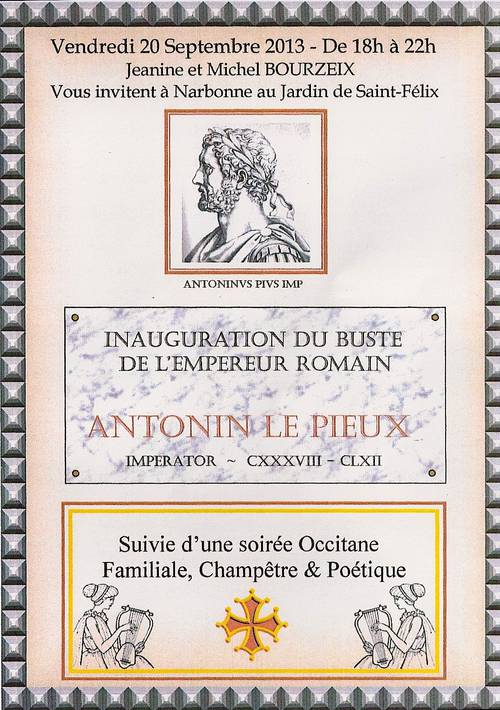
Some notes; the life of Antonin the Pious.
He was called pious because he saved some senators from execution; they were accused by his father Hadrian, who was "ill" at the time he judged them. Later Antonin changed the law; accused people were not to be treated as guilty before they were tried. He reduced the incidence of torture, especially towards slaves, and prohibited it altogether for children under fourteen. At last Rome was moving away from barbarity.
Antonin married Faustina, who devoted her life towards caring for the poor. Antonin was devastated when she died in 141AD and deified her, building a temple to her in the Forum, where she was served by priestesses. When he died he was buried beside her and was also deified.
Our host Michel admires Antonin simply as a good man who supported Narbonne. In 25 years of his reign Antonin never went near the army and no wars were fought.
Antonin's successor was Marcus Aurelius, his adopted son. Marcus was called a philosopher and was more pious than his father. The "Meditations of Marcus Aurelius" are still used for spiritual guidance today.
Inscrivez-vous au blog
Soyez prévenu par email des prochaines mises à jour
Rejoignez les 28 autres membres

